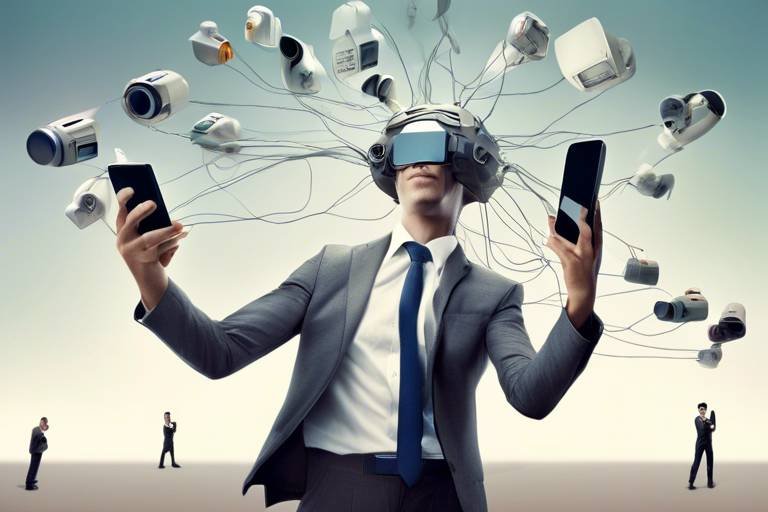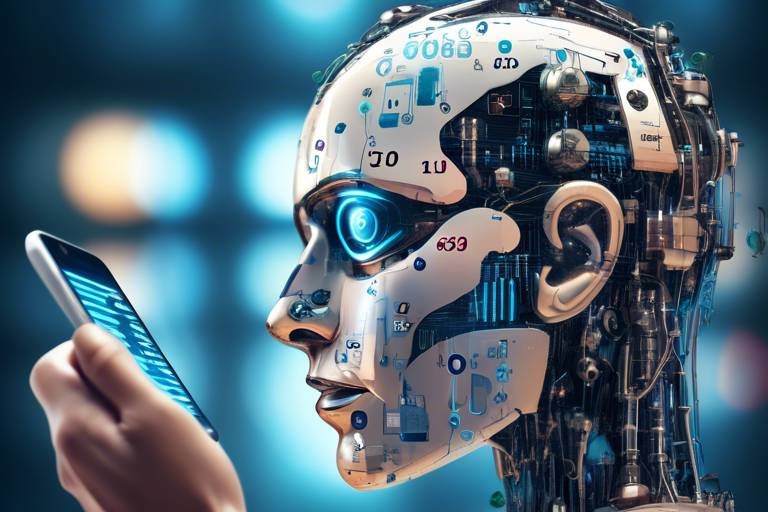The Next Generation of Internet - Web 3.0 Explained
Welcome to the future of the internet! If you think the internet has already reached its peak, think again. We are on the brink of a revolutionary shift known as Web 3.0. This new era is not just an upgrade; it's a complete transformation of how we interact online. Imagine a world where you have complete control over your data, where your online interactions are secure and transparent, and where businesses operate in a way that prioritizes user engagement over profit. Sounds exciting, right? Let's dive deeper into what Web 3.0 really means and how it's set to change our digital lives forever.
So, what exactly is Web 3.0? At its core, Web 3.0 represents the third era of the internet, a phase that emphasizes decentralization, user empowerment, and enhanced data privacy. Unlike its predecessors—Web 1.0, which was static and read-only, and Web 2.0, which introduced user-generated content but still relied heavily on centralized platforms—Web 3.0 is built on the principles of trust, transparency, and user ownership. Think of it as a digital landscape where your data is your own, and you have the power to decide how and when it's used.
The defining characteristics of Web 3.0 are what make it so revolutionary. First and foremost, we have semantic understanding. This means that the internet will be able to understand and interpret information much like humans do, allowing for more meaningful interactions and personalized experiences. Next, we have decentralized networks, which reduce the reliance on central authorities and create a more democratic internet. Lastly, the integration of blockchain technology ensures that transactions are secure, transparent, and immutable. Each of these features plays a crucial role in shaping the future of online interactions.
Decentralization is the backbone of Web 3.0. Imagine a world where you don’t have to rely on big corporations to control your online experiences. With decentralized systems, users can interact directly with one another without intermediaries. This not only enhances security and privacy but also gives users greater control over their personal data. No longer will you have to worry about your information being sold to the highest bidder. Instead, you can choose how your data is used, making the internet a safer place for everyone.
Now, let’s talk about blockchain technology. This is the engine that drives many Web 3.0 applications. Think of it as a digital ledger that records transactions across multiple computers in such a way that the registered transactions cannot be altered retroactively. This technology fosters trust among users because it provides a transparent way to conduct transactions without the need for a central authority. Whether you’re buying digital art or engaging in smart contracts, blockchain ensures that your transactions are secure and verifiable.
Speaking of smart contracts, these are another game-changer in the Web 3.0 landscape. A smart contract is a self-executing contract with the terms of the agreement directly written into code. This means that agreements can be automated, reducing the need for intermediaries. Imagine a rental agreement that automatically transfers payment once conditions are met—no more waiting for checks to clear! The advantages of smart contracts are numerous, including increased efficiency, reduced costs, and enhanced security.
One of the most exciting aspects of Web 3.0 is its focus on user empowerment. Users will finally have ownership of their data, which transforms their experiences and interactions with digital platforms. Instead of being passive consumers, individuals will become active participants in the digital economy. This shift not only enhances user experiences but also encourages innovation, as businesses will need to adapt to meet the evolving expectations of empowered users.
The transition to Web 3.0 presents both challenges and opportunities for businesses. On one hand, companies must adapt to a new landscape that prioritizes transparency and user engagement. On the other hand, this new environment offers innovative ways to connect with customers and create value. Businesses that embrace the principles of Web 3.0 can leverage its benefits for growth, but those that resist change may find themselves left behind.
Web 3.0 encourages the emergence of new business models based on decentralization and user engagement. Companies can explore models that prioritize community involvement and user feedback, creating a more collaborative and interactive experience. For instance, businesses can utilize decentralized finance (DeFi) platforms to offer financial services without traditional banking structures, disrupting industries and opening new revenue streams.
Despite its potential, adopting Web 3.0 technologies poses several challenges. Regulatory hurdles and technological barriers can slow down the transition. Businesses must navigate these obstacles while also educating their teams and customers about the benefits of this new paradigm. However, with strategic planning and a willingness to innovate, companies can successfully make the leap into the world of Web 3.0.
- What is Web 3.0? Web 3.0 is the third era of the internet, focusing on decentralization, user empowerment, and enhanced data privacy.
- How does blockchain technology work? Blockchain is a decentralized digital ledger that records transactions across multiple computers, ensuring security and transparency.
- What are smart contracts? Smart contracts are self-executing contracts with the terms directly written into code, allowing for automated agreements without intermediaries.
- What are the benefits of Web 3.0 for users? Users gain ownership of their data, enhanced privacy, and more personalized online experiences.
- What challenges do businesses face in adopting Web 3.0? Businesses may encounter regulatory hurdles and technological barriers that can impede the transition.

[Understanding Web 3.0]
Web 3.0 represents a monumental shift in how we interact with the internet. Imagine the internet as a living organism, evolving through distinct stages. The first stage, Web 1.0, was like a library—static, informative, but lacking interactivity. Then came Web 2.0, which transformed the internet into a bustling marketplace where users could engage, share, and create content. Now, we stand on the brink of Web 3.0, a phase that emphasizes decentralization, user empowerment, and enhanced data privacy.
So, what does it mean to embrace decentralization? In simple terms, it means moving away from centralized platforms that control user data and interactions. Think about it: in the current digital landscape, giant corporations hold the keys to our online identities. They dictate what we see, how we interact, and even how our data is used. Web 3.0 aims to flip this script, giving power back to the users. This new era encourages a more democratic internet where individuals have control over their information and can interact directly with one another without the need for intermediaries.
One of the foundational concepts of Web 3.0 is the semantic web. This term refers to the ability of machines to understand and interpret data in a human-like way. Imagine a world where search engines not only retrieve information but also comprehend the context and intent behind your queries. This means you’ll receive more relevant results tailored to your needs. The semantic web paves the way for smarter applications that can learn from user interactions, making your online experience more intuitive and personalized.
Another crucial aspect is the use of blockchain technology. This technology serves as the backbone for many Web 3.0 applications, providing a decentralized ledger that records transactions transparently and securely. It’s like having a digital notebook that everyone can see but no one can alter. This fosters trust among users, as they can verify transactions independently without relying on a central authority. In essence, blockchain technology enhances security and accountability in online interactions.
As we delve deeper into the world of Web 3.0, it becomes clear that this evolution is not just about technology; it’s about transforming our relationship with the internet. It’s about creating an ecosystem where users are not just passive consumers but active participants. By giving users ownership of their data and enabling them to control how it’s used, Web 3.0 promises to revolutionize the way we engage with digital platforms.
In summary, understanding Web 3.0 requires us to recognize its core principles: decentralization, semantic understanding, and blockchain technology. These elements work together to create a more user-centric internet that prioritizes privacy, security, and empowerment. As we prepare to navigate this new digital landscape, it’s essential to grasp these concepts and consider how they will impact our online experiences.

[Key Features of Web 3.0]
Web 3.0 is not just an upgrade; it's a revolution in how we interact with the internet. Imagine a world where your data is truly yours, where you have control over your digital identity, and where interactions are more meaningful and secure. The key features of Web 3.0 are designed to make this vision a reality. Let's dive into these groundbreaking characteristics that set Web 3.0 apart from its predecessors.
One of the most significant features of Web 3.0 is semantic understanding. This means that the internet will not only understand the words you type but also the context behind them. Think of it as having a conversation with a friend who gets you. This semantic web will allow for more personalized experiences and smarter search results, making it easier for users to find exactly what they’re looking for without sifting through irrelevant information.
Another cornerstone of Web 3.0 is decentralized networks. Unlike traditional web structures that rely heavily on centralized servers and authorities, Web 3.0 promotes a network where users can connect directly with each other. This decentralization enhances security and privacy, as there is no single point of failure. Imagine a library where every book is owned by the readers themselves rather than a large corporation; that's the essence of decentralization in Web 3.0.
At the heart of many Web 3.0 applications lies blockchain technology. This technology allows for transparent and secure transactions without the need for intermediaries. When you think of blockchain, picture a digital ledger that everyone can see but no one can alter. This fosters trust among users, as they can verify transactions independently. Blockchain is the backbone of cryptocurrencies, but its applications extend far beyond that, including supply chain management, voting systems, and digital identity verification.
Now, let’s talk about smart contracts. These are self-executing contracts with the terms of the agreement directly written into code. Picture a vending machine: you insert money, select your product, and the machine automatically delivers what you chose. Smart contracts work similarly, automating agreements without needing a middleman. This not only speeds up transactions but also reduces costs and the potential for disputes. Various industries, from real estate to entertainment, are exploring how smart contracts can streamline processes and enhance trust.
In summary, the key features of Web 3.0—semantic understanding, decentralized networks, blockchain technology, and smart contracts—are all geared towards creating a more user-centric internet. They empower users, enhance security, and foster trust, paving the way for a digital ecosystem that prioritizes individual control and privacy. As we transition into this new era, the implications for both users and businesses are profound, setting the stage for a more equitable online experience.
- What is Web 3.0? Web 3.0 is the next evolution of the internet, focusing on decentralization, user control, and enhanced data privacy.
- How does semantic understanding work? It allows the internet to understand context and meaning, making searches more intuitive and personalized.
- What role does blockchain play in Web 3.0? Blockchain provides a secure and transparent way to conduct transactions, eliminating the need for intermediaries.
- What are smart contracts? Smart contracts are self-executing agreements with terms directly written into code, automating transactions and reducing disputes.

[Decentralization]
Decentralization is not just a buzzword in the realm of technology; it is the heartbeat of Web 3.0. Imagine a world where no single entity holds the keys to your data or controls your online interactions. This is the promise of decentralization, a fundamental shift that minimizes reliance on central authorities. In the traditional web, companies like social media giants and tech behemoths dictate the rules, often prioritizing profit over user privacy. However, with the advent of Web 3.0, we are stepping into a realm where users regain control.
One of the most significant advantages of decentralization is enhanced security. In centralized systems, a single point of failure can lead to massive data breaches. Think of it as a bank vault: if someone breaks in, they can steal everything. In contrast, decentralized networks distribute data across many nodes, making it incredibly challenging for hackers to target a single source. This model not only protects personal information but also fosters a sense of trust among users.
Moreover, decentralization empowers users by allowing them to control their own data. Instead of handing over personal information to corporations, users can choose what to share and with whom. This shift transforms the user experience, turning passive consumers into active participants in the digital economy. Users can now engage in peer-to-peer transactions without intermediaries, eliminating unnecessary fees and enhancing the overall efficiency of online interactions.
To illustrate the impact of decentralization, consider the following key aspects:
- Enhanced Privacy: Users can choose to keep their data private, sharing it only when they feel comfortable.
- Greater Control: Individuals have the power to manage their online identities and digital assets.
- Resilience: Decentralized networks are more resistant to censorship and attacks, ensuring that the flow of information remains uninterrupted.
As we embrace this new paradigm, it's essential to understand that decentralization is not just about technology; it's about redefining relationships between users and platforms. In this new landscape, users become stakeholders, contributing to the governance and direction of the platforms they engage with. This shift could lead to a more equitable internet, where everyone has a voice and a stake in the digital economy.
In conclusion, decentralization is a game-changer in the Web 3.0 landscape. It not only enhances security and privacy but also empowers users to take control of their digital lives. As we move forward, the implications of this shift will be profound, shaping the future of online interactions and redefining the way we think about data ownership.
- What is decentralization in Web 3.0?
Decentralization refers to the distribution of control and data across a network, reducing reliance on central authorities and enhancing user empowerment. - How does decentralization improve security?
By distributing data across multiple nodes, decentralized systems eliminate single points of failure, making it harder for hackers to access sensitive information. - Can users really control their data in a decentralized web?
Yes, users have the ability to manage their own data and decide what to share, fostering greater privacy and control over personal information.

[Blockchain Technology]
At the heart of Web 3.0 lies blockchain technology, a revolutionary system that is reshaping how we think about transactions and data management online. Imagine a digital ledger that is not only secure but also transparent and immutable. This technology allows multiple parties to access the same information without needing a central authority to verify it. In simpler terms, it’s like having a group of friends who all keep their own copies of a diary, ensuring that no one can alter the past entries without everyone noticing.
So, how does blockchain work? At its core, blockchain is a decentralized database that records transactions across many computers in such a way that the registered transactions cannot be altered retroactively. This means that once a transaction is added to the chain, it becomes part of a permanent record. Each block in the chain contains a list of transactions, a timestamp, and a cryptographic hash of the previous block, linking them together in a secure manner. Think of it as a chain of digital locks, where each lock is uniquely tied to the previous one, making it virtually impossible to tamper with without detection.
One of the most significant aspects of blockchain technology is its ability to foster trust among users. In a world where data breaches and fraud are rampant, blockchain offers a solution by ensuring that all parties involved in a transaction can trust the data without needing to trust each other. This is particularly valuable in sectors like finance, supply chain management, and healthcare, where the integrity of data is paramount. For instance, in supply chains, blockchain can track the journey of a product from its origin to the consumer, providing transparency and accountability at every step.
Moreover, blockchain technology supports the creation of decentralized applications (dApps) that operate on a peer-to-peer network rather than being hosted on centralized servers. This not only enhances security but also gives users more control over their data. Imagine being able to use an app without worrying about your personal information being sold to advertisers or misused by third parties. With blockchain, users can engage with dApps while having a greater say in how their data is handled.
To illustrate the impact of blockchain technology, consider the following table that summarizes its key features and benefits:
| Feature | Benefit |
|---|---|
| Decentralization | Reduces reliance on central authorities, enhancing security and privacy. |
| Transparency | All transactions are visible to all participants, fostering trust. |
| Immutability | Once recorded, transactions cannot be altered, ensuring data integrity. |
| Smart Contracts | Automates agreements, reducing the need for intermediaries. |
In conclusion, blockchain technology is not just a buzzword; it is a foundational element of Web 3.0 that empowers users, enhances security, and promotes trust in digital transactions. As we continue to explore this new internet landscape, understanding blockchain's capabilities will be crucial for both individuals and businesses looking to thrive in this decentralized world.

[Smart Contracts]
Imagine a world where contracts execute themselves without the need for a middleman. Smart contracts are revolutionizing how we think about agreements in the digital age. These self-executing contracts are coded onto a blockchain, which means they automatically enforce and execute the terms of an agreement once predetermined conditions are met. This eliminates the need for intermediaries, such as lawyers or notaries, thereby reducing costs and increasing efficiency.
At their core, smart contracts are simply lines of code that run on decentralized networks. They can be used in various industries, from finance and real estate to healthcare and supply chain management. For instance, in the real estate sector, a smart contract could automatically transfer ownership of a property once payment is made, streamlining the entire process and minimizing the risk of fraud.
One of the most appealing aspects of smart contracts is their transparency. Since they operate on a blockchain, all participants can view the contract's code and its execution history. This level of visibility fosters trust among parties involved, as everyone knows that the terms cannot be altered without consensus. Additionally, the use of smart contracts can significantly reduce the time it takes to complete transactions. Traditional agreements often involve lengthy negotiations and paperwork, but with smart contracts, execution can happen in a matter of seconds.
However, while the advantages of smart contracts are compelling, there are challenges to consider. For example, the immutability of blockchain means that if a smart contract is poorly coded or contains errors, those mistakes cannot be easily rectified. This raises the importance of rigorous testing and auditing before deployment. Furthermore, legal recognition of smart contracts varies by jurisdiction, which can complicate their adoption.
In summary, smart contracts represent a significant leap forward in how we manage agreements and transactions in a decentralized world. By eliminating intermediaries, enhancing transparency, and speeding up processes, they hold the potential to transform numerous industries. As we continue to explore the possibilities of Web 3.0, smart contracts will undoubtedly play a pivotal role in shaping the future of online interactions.
- What are smart contracts? Smart contracts are self-executing contracts with the terms of the agreement directly written into code on a blockchain.
- How do smart contracts work? They automatically execute and enforce contract terms when predetermined conditions are met, without needing intermediaries.
- What industries can benefit from smart contracts? Various sectors, including finance, real estate, healthcare, and supply chain management, can leverage smart contracts for efficiency and transparency.
- Are smart contracts legally binding? The legal status of smart contracts varies by jurisdiction, and it is essential to understand local laws regarding their enforceability.

[User Empowerment]
In the rapidly evolving landscape of the internet, User Empowerment stands out as a pivotal feature of Web 3.0. Imagine a world where you, the user, have complete control over your data, much like owning the rights to your own artwork. This shift is not merely a trend; it's a fundamental transformation in how we interact with digital platforms. With Web 3.0, users are no longer at the mercy of centralized corporations that dictate terms and conditions, often without transparency. Instead, they are empowered to make choices that directly impact their online experiences.
So, what does this empowerment look like in practice? First and foremost, it means that users can manage their own identities and data. In the past, signing up for a service often meant relinquishing control of personal information to a third party. Now, thanks to decentralized identity solutions, users can authenticate themselves without exposing their entire data profile. This is akin to having a digital key that opens only the doors you choose, rather than giving someone a master key to your entire life.
Furthermore, Web 3.0 introduces the concept of tokenization, which allows users to own a piece of the platforms they engage with. Think of it like owning shares in a company; the more you contribute to a platform, the more you benefit from its success. This creates a symbiotic relationship between users and platforms, where both parties are incentivized to thrive together. Users can earn tokens for their contributions, whether that's creating content, providing feedback, or participating in governance decisions.
This empowerment also extends to the realm of data privacy. With the rise of blockchain technology, users have the ability to control who accesses their data and for what purpose. It's a significant departure from the traditional model where companies harvest user data without clear consent. Now, users can choose to share their data selectively, and even monetize it if they wish. This level of control is revolutionary; it’s like being the owner of a treasure chest where you decide who gets a peek inside.
In addition to data control, Web 3.0 emphasizes community governance. Users are not just passive consumers; they are active participants in decision-making processes. Through decentralized autonomous organizations (DAOs), users can vote on important issues, propose changes, and influence the future direction of platforms. This democratization of power fosters a sense of belonging and ownership, making users feel like they are part of something bigger. It’s like being part of a local community where every voice matters, rather than being just another number in a corporate database.
In conclusion, the transition to Web 3.0 heralds a new era of User Empowerment that prioritizes individual control, privacy, and community engagement. As we embrace these changes, users can look forward to a more equitable and transparent digital landscape. The question now is: are you ready to take control of your online identity and become an active participant in the digital world?
- What is Web 3.0? Web 3.0 is the next generation of the internet characterized by decentralization, user empowerment, and enhanced data privacy.
- How does Web 3.0 empower users? It gives users control over their data, allows them to participate in governance, and enables them to benefit financially from their contributions.
- What are decentralized autonomous organizations (DAOs)? DAOs are organizations that are governed by smart contracts on the blockchain, allowing users to vote on decisions and propose changes.
- Why is data privacy important in Web 3.0? It ensures that users have control over their personal information and can choose who accesses it, reducing the risk of data exploitation.

[Implications for Businesses]
The transition to Web 3.0 is not just a technological shift; it's a paradigm shift that has profound implications for businesses across the globe. As we move into this new era, companies must adapt to a landscape that prioritizes decentralization, user empowerment, and enhanced privacy. This new framework offers a wealth of opportunities but also presents significant challenges that businesses must navigate to thrive.
One of the most exciting aspects of Web 3.0 is the potential for new business models that leverage decentralized technologies. Traditional businesses often rely on centralized systems, which can create bottlenecks and inefficiencies. In contrast, Web 3.0 encourages companies to rethink their strategies and explore innovative models that foster direct engagement with users. For instance, decentralized finance (DeFi) platforms allow users to lend, borrow, and earn interest on their assets without intermediaries, which can disrupt traditional banking systems. This shift not only empowers users but also opens up new revenue streams for businesses willing to embrace these changes.
Moreover, the concept of tokenization in Web 3.0 allows businesses to create unique digital assets representing ownership or access to goods and services. This can lead to entirely new markets and customer experiences. For example, artists can tokenize their work, allowing fans to invest directly in their projects, creating a more personal connection and a sustainable revenue model. Businesses that harness the power of tokenization can tap into new customer bases and enhance their brand loyalty.
However, the transition to Web 3.0 isn't without its challenges. Companies must grapple with regulatory hurdles as governments around the world begin to catch up with these rapid technological advancements. Compliance with evolving regulations can be daunting, particularly for startups and smaller enterprises. Additionally, the technological barriers to entry can be significant. Many businesses may lack the necessary infrastructure or expertise to implement Web 3.0 technologies effectively. This is where partnerships and collaborations come into play. By teaming up with tech-savvy firms or investing in employee training, businesses can position themselves to leverage the advantages of this new internet era.
In summary, as we stand on the brink of the Web 3.0 revolution, businesses must be proactive in understanding its implications. Embracing new business models, leveraging tokenization, and navigating regulatory landscapes will be crucial for success in this decentralized ecosystem. Those who adapt quickly and effectively will not only survive but thrive in the exciting new world of Web 3.0.
- What is Web 3.0? Web 3.0 is the next generation of the internet that emphasizes decentralization, user empowerment, and enhanced data privacy.
- How can businesses benefit from Web 3.0? Businesses can leverage new decentralized business models, enhance user engagement, and explore tokenization to create new revenue streams.
- What challenges do businesses face in adopting Web 3.0? Regulatory hurdles and technological barriers are significant challenges that businesses must navigate to adopt Web 3.0 technologies effectively.

[New Business Models]
As we step into the era of Web 3.0, businesses are finding themselves at a crossroads, where traditional models are being challenged and innovative approaches are emerging. The concept of decentralization is not just a buzzword; it's a fundamental shift that encourages companies to rethink how they engage with customers and manage their operations. Imagine a world where businesses are not controlled by a single entity but thrive on community-driven ecosystems. This is where new business models come into play.
One of the most exciting aspects of Web 3.0 is the rise of decentralized autonomous organizations (DAOs). These organizations operate on blockchain technology and are governed by smart contracts, allowing for a level of transparency and community involvement that was previously unimaginable. In a DAO, decisions are made collectively, and every member has a voice. This model not only fosters trust but also aligns the interests of users and stakeholders, creating a more engaged and loyal customer base.
Furthermore, the concept of tokenization is revolutionizing how businesses interact with their customers. By creating digital tokens that represent ownership or access rights, companies can incentivize participation and loyalty in ways that traditional loyalty programs simply cannot. For instance, a coffee shop might issue tokens for every purchase, which customers can later redeem for discounts or exclusive products. This not only enhances customer engagement but also creates a new revenue stream for businesses.
Another significant shift is the emergence of peer-to-peer (P2P) marketplaces. These platforms allow users to buy and sell directly with one another, cutting out the middleman and reducing costs. Think of it as a digital flea market where everyone can showcase their products or services. This model empowers individuals, promotes entrepreneurship, and creates a more vibrant economy. As a result, businesses must adapt to this new landscape by finding ways to integrate with P2P platforms or even creating their own.
To illustrate these new business models, consider the following table:
| Business Model | Description | Benefits |
|---|---|---|
| Decentralized Autonomous Organizations (DAOs) | Organizations governed by smart contracts, allowing for collective decision-making. | Enhanced transparency, community engagement, and trust. |
| Tokenization | Creating digital tokens to represent ownership or access rights. | Increased customer loyalty and new revenue streams. |
| Peer-to-Peer Marketplaces | Platforms facilitating direct transactions between users. | Reduced costs, empowered individuals, and vibrant economies. |
In conclusion, the transition to Web 3.0 is not merely a technological upgrade; it’s a reimagining of how businesses operate and interact with their customers. As companies explore these new models, they will need to embrace flexibility, innovation, and a customer-centric approach to thrive in this decentralized landscape. The future is bright for those willing to adapt and seize the opportunities that Web 3.0 presents.
What is Web 3.0?
Web 3.0 is the third era of the internet, focusing on decentralization, user empowerment, and enhanced data privacy. It aims to create a more user-centric online environment.
How do DAOs work?
DAOs operate on blockchain technology and are governed by smart contracts. Members can vote on decisions, making it a collective and transparent way to manage organizations.
What are the benefits of tokenization?
Tokenization allows businesses to create digital tokens that can incentivize customer loyalty and participation, creating new revenue streams and enhancing customer engagement.
How do peer-to-peer marketplaces benefit users?
P2P marketplaces allow users to buy and sell directly with one another, reducing costs and empowering individuals to participate in the economy without intermediaries.

[Challenges in Adoption]
As we stand on the brink of a new digital era with Web 3.0, it's crucial to recognize that the journey toward this decentralized future isn't without its hurdles. Adopting Web 3.0 technologies presents a unique set of challenges that can make organizations hesitant to fully embrace this innovative landscape. So, what are these challenges? Let's dive in!
First and foremost, regulatory hurdles pose a significant barrier. Governments around the world are still trying to wrap their heads around the implications of decentralized systems and blockchain technology. Without clear regulations, businesses may fear legal repercussions or compliance issues. This uncertainty can stifle innovation and slow down the adoption process. In fact, many companies are waiting to see how regulations will evolve before committing significant resources to Web 3.0 initiatives.
Moreover, there are technological barriers that can't be ignored. Implementing Web 3.0 solutions often requires a shift in infrastructure and resources. For instance, companies may need to invest in new technologies or retrain their workforce to adapt to decentralized systems. The technical complexity of blockchain and smart contracts can also be daunting for organizations that lack the necessary expertise. This leads to a situation where businesses might feel overwhelmed, opting to stick with familiar, traditional systems instead.
Another challenge is the lack of user awareness and education. While the potential of Web 3.0 is immense, many users remain unaware of its benefits and functionalities. This knowledge gap can hinder user adoption, as people are typically reluctant to engage with technologies they don’t fully understand. Businesses need to invest in educational programs to bridge this gap, ensuring that both employees and customers are well-informed about the advantages of transitioning to a decentralized ecosystem.
Additionally, the interoperability of systems can create friction in the adoption process. Web 3.0 is characterized by a multitude of platforms and technologies, each with its own protocols and standards. For businesses, this means navigating a complex web of systems that may not communicate effectively with one another. Achieving seamless integration across various platforms is vital for creating a user-friendly experience, but it can also be a daunting task.
Lastly, security concerns cannot be overlooked. While decentralization offers enhanced security features, it also introduces new vulnerabilities. Cyberattacks on blockchain networks, for instance, can have catastrophic consequences. Businesses must prioritize security measures to protect their systems and users’ data, which can require substantial investment and ongoing vigilance.
In summary, while the transition to Web 3.0 holds tremendous potential for innovation and user empowerment, it is accompanied by several challenges that businesses must navigate. By understanding these obstacles—regulatory hurdles, technological barriers, lack of user education, interoperability issues, and security concerns—companies can better prepare themselves for a successful transition into this new digital landscape.
- What is Web 3.0? Web 3.0 is the next generation of the internet that emphasizes decentralization, user control, and enhanced privacy.
- Why is decentralization important in Web 3.0? Decentralization reduces reliance on central authorities, enhancing security and giving users more control over their data.
- What role does blockchain play in Web 3.0? Blockchain technology provides a secure and transparent method for transactions and data storage, fostering trust among users.
- What challenges do businesses face when adopting Web 3.0? Key challenges include regulatory hurdles, technological barriers, lack of user awareness, interoperability issues, and security concerns.
Frequently Asked Questions
- What is Web 3.0?
Web 3.0 is the third generation of the internet that focuses on decentralization, user empowerment, and enhanced data privacy. It aims to transform how we interact online by reducing reliance on central authorities and giving users more control over their data.
- How does decentralization work in Web 3.0?
Decentralization in Web 3.0 means that no single entity controls the data or the platform. Instead, information is distributed across a network of computers, enhancing security and privacy while allowing users to maintain ownership of their personal data.
- What role does blockchain play in Web 3.0?
Blockchain technology is fundamental to Web 3.0 as it enables secure and transparent transactions. It allows for the creation of decentralized applications (dApps) that operate without intermediaries, fostering trust and accountability among users.
- What are smart contracts?
Smart contracts are self-executing contracts with the terms of the agreement directly written into code. They automate processes and transactions, reducing the need for intermediaries and increasing efficiency in various industries.
- How does Web 3.0 empower users?
Web 3.0 empowers users by giving them ownership of their data and control over how it is used. This shift not only enhances privacy but also transforms user experiences, allowing for more personalized and engaging interactions with digital platforms.
- What are the implications of Web 3.0 for businesses?
The transition to Web 3.0 presents both challenges and opportunities for businesses. Companies can leverage decentralized technologies to create innovative business models, improve customer engagement, and enhance security, but they must also navigate regulatory hurdles and technological barriers.
- What challenges do businesses face in adopting Web 3.0?
Businesses may encounter several challenges when adopting Web 3.0 technologies, including regulatory compliance, the need for new skill sets, and technological barriers. Addressing these challenges is crucial for a successful transition to this new digital landscape.



















